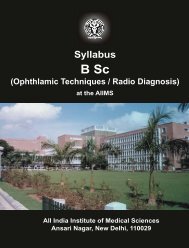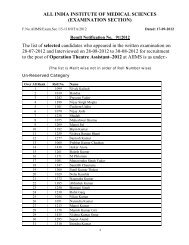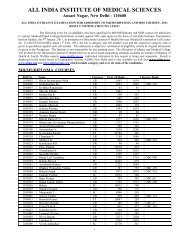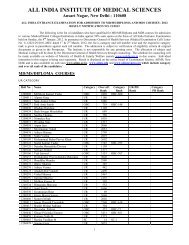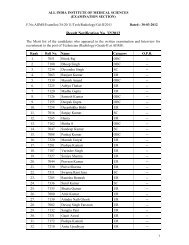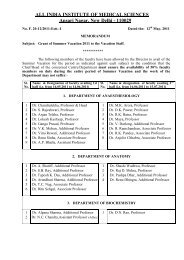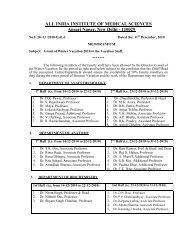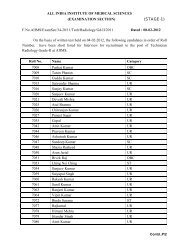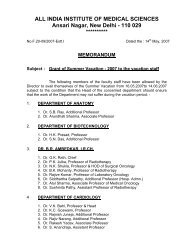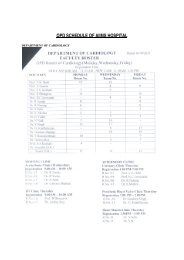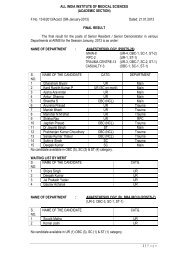Manual for long-term pharmacotherapy - All India Institute of Medical ...
Manual for long-term pharmacotherapy - All India Institute of Medical ...
Manual for long-term pharmacotherapy - All India Institute of Medical ...
You also want an ePaper? Increase the reach of your titles
YUMPU automatically turns print PDFs into web optimized ePapers that Google loves.
Direct relationship between craving and relapse, though not well established, appears to occur through<br />
in<strong>term</strong>ediate factors.<br />
Craving <strong>for</strong> alcohol is generally thought to arise either from the desire to experience alcohol's positive effects or<br />
from the desire to avoid the negative effects <strong>of</strong> withholding alcohol, such as withdrawal symptoms. Other<br />
models have suggested other important dimensions <strong>of</strong> craving, such as the desire and intention to consume<br />
alcohol, lack <strong>of</strong> control over alcohol use, and preoccupation with drinking-related thoughts and behavior.<br />
Irrespective <strong>of</strong> the model used <strong>for</strong> understanding 'craving', it is suggested that the <strong>term</strong> should be used only to<br />
convey a 'strong desire' to take drug.<br />
Craving measures fall into two main categories with respect to their timeframe: (1) state measures, <strong>of</strong> current<br />
craving status, and (2) global measures, which ask the patient to describe his or her general experience <strong>of</strong><br />
craving over the course <strong>of</strong> 1 day, 1 week, 1 month, or an even <strong>long</strong>er time period.<br />
Incorporating craving measurements into routine clinical practice can produce several potential benefits. Its<br />
assessment can increase the patient's capacity to recognize and monitor his internal states that are related to<br />
drinking and this can be used in recommending appropriate treatment and in decisions regarding treatment<br />
intensity and duration. Studies have suggested that alcoholics who report higher levels <strong>of</strong> craving benefit the<br />
most from the anti-craving medication like naltrexone.<br />
After this brief discussion on craving we now discuss the pharmacology and evidence-base <strong>for</strong> some <strong>of</strong> the<br />
important anti-craving agents.<br />
Anti-Craving Medications <strong>for</strong> Alcoholism<br />
I. ACAMPROSATE<br />
Mechanism <strong>of</strong> Action<br />
Acamprosate (calcium acetylhomotaurinate) is a simple derivative <strong>of</strong> the essential taurine amino acid and<br />
displays a structural resemblance to gamma-amino butyric acid (GABA). Acamprosate enhances the<br />
GABAergic neurotransmitter system, which is reduced in persons with chronic exposure to alcohol, and<br />
interferes with glutamate action in different pathways, such as the N-methyl-D-aspartate (NMDA) receptors.<br />
Acamprosate also acts on the calcium channels and reduces central nervous system hyperexcitability caused<br />
by cessation <strong>of</strong> alcohol intake. Acamprosate is thought to work by decreasing craving related to conditioned<br />
withdrawal.<br />
Evidence-base<br />
Studies conducted involving more than 4000 patients with alcohol dependence who had completed<br />
detoxification, provide consistent evidence <strong>of</strong> the efficacy <strong>of</strong> acamprosate in alcoholism rehabilitation; Most<br />
studies were randomized controlled trials comparing acamprosate with placebo or other anticraving agent<br />
such as Naltrexone. These outcomes have shown to be substantially homogeneous. Overall it was found that<br />
with acamprosate there is an increase in the cumulative abstinence period, decrease in the likelihood <strong>of</strong> return<br />
14




